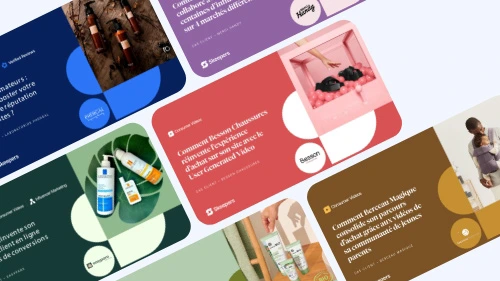User-Generated Content (UGC) marketing revolves around the creation, curation, and amplification of content produced by consumers rather than brands themselves. In essence, it harnesses the authentic and diverse voices of a brand’s audience to shape its narrative. The landscape of consumer influence has undergone a profound transformation in recent years, moving away from traditional advertising models to a more dynamic and participatory approach.
Consumers now play an active role in shaping brand perceptions, making purchase decisions, and influencing their peers. Social media platforms have become powerful mediums for individuals to share their experiences, opinions, and creative expressions, contributing to a democratization of influence.
Evolution of Consumer Influence

The evolution of consumer influence has witnessed a notable shift from the traditional advertising model to the dynamic landscape of UGC Marketing.
- Traditional Advertising: Historically, consumer influence was largely shaped by top-down, brand-driven messages delivered through conventional advertising channels such as TV, radio, and print.
- UGC Marketing: In contrast, UGC Marketing empowers shoppers to become co-creators of content, contributing to the brand narrative and influencing their peers through authentic, user-generated materials.
Shifting Dynamics in Consumer Decision-Making
The dynamics of consumer decision-making have experienced a seismic transformation, influenced by the rise of UGC Marketing. People previously relied heavily on brand-generated content and advertisements for product information and decision-making. With UGC, shoppers now place increased trust in the experiences and opinions of their peers, valuing authentic and relatable content over polished corporate messaging.
The explosive growth of UGC can be largely attributed to the pervasive influence of social media platforms.
- Amplification on Social Media: Platforms like Instagram, TikTok, and YouTube provide the ideal stage for UGC to flourish, allowing users to share their creations, experiences, and opinions with a global audience.
- Community Building: Social media facilitates the formation of communities around brands, enabling users to engage in conversations, share insights, and contribute to the collective identity of the brand.
The intersection of these factors underscores the transformative power of UGC Marketing, positioning consumers as active contributors in shaping brand narratives and influencing the decisions of their peers.
The Power of UGC

The impact of UGC on brand trust and authenticity is profound, shaping consumer perceptions in unique ways. UGC inherently carries a sense of authenticity and genuineness, as it originates from real users rather than brand-driven content.
The peer-to-peer nature of UGC contributes to building trust, as shoppers often trust the experiences and opinions of their peers more than traditional advertising.
Authenticity and Trust in UGC
UGC has become a powerful tool for brands to build authenticity and trust with their audiences. Unlike traditional advertising, which often feels polished and brand-driven, UGC is created by real people who share their genuine experiences, making it inherently more relatable and trustworthy.
UGC Offers an Unfiltered Perspective
People today are highly discerning and often skeptical of traditional ads that may seem overly curated, or sales focused. UGC, on the other hand, offers an unfiltered and authentic perspective. When people see content created by others who have actually used a product or service, it resonates on a personal level, making the brand feel more accessible and trustworthy. UGC humanizes many brands by showing real-life experiences, which creates a sense of community and reliability.
Key reasons UGC enhances authenticity and trust:
- Real experiences: UGC comes from real users sharing their personal stories, making it more credible than professionally produced content.
- Relatability: Shoppers can often see themselves in UGC, as it reflects the thoughts, emotions, and usage scenarios of everyday people.
- Social proof: UGC acts as social proof, where positive reviews and experiences from peers encourage others to follow suit, increasing confidence in the brand.
Why Consumers Rely on Peer-Generated Content and Reviews
Consumers place more trust in their peers than in brands themselves. In fact, research shows that people are more likely to trust reviews, testimonials, and social media posts from other customers than they are to trust traditional ads. This is because peer-generated content offers an unbiased, third-party perspective, making it feel more honest and less like a direct marketing pitch.
Consumers view UGC as transparent since it showcases the good and bad of a product or service. This openness makes the positive feedback more believable. Recommendations from family, friends, or even online communities feel more personal, which is why according to Skeepers’ data report 75% of people say UGC impacts their purchasing decisions. UGC taps into emotions, often showcasing the real-life impact a product or service has on users, which resonates more deeply than a generic ad.
UGC and Brand Loyalty
When customers actively participate in creating content for a brand, they feel a stronger connection to that brand, transforming them from mere buyers into passionate advocates. This connection helps brands cultivate lasting relationships that go beyond one-time transactions.
UGC has a unique ability to make customers feel seen and valued.
By encouraging and sharing content from real customers, marketers can demonstrate that they care about their customers’ voices and experiences. This recognition fosters deeper loyalty because shoppers feel personally invested in the brand’s success.
When consumers create content for a brand, whether it’s a product review, social media post, or testimonial, they are emotionally investing in that brand. This involvement deepens their connection and increases the likelihood of repeat purchases.
By showcasing UGC on platforms like social media, websites, or in marketing campaigns, brands offer a form of public recognition. This recognition builds a sense of belonging, making customers more likely to remain loyal.
How to Use UGC to Build Community and Repeat Engagement
To leverage UGC as a tool for building long-term brand loyalty, brands should focus on strategies that encourage active participation and create opportunities for customers to engage with both the brand and each other.
Create UGC Campaigns That Encourage Participation
Brands can launch campaigns that invite customers to share their experiences with a product or service. For example, hashtags challenges, contests, or specific calls to action (such as “share your story”) can motivate shoppers to create and submit content. By engaging with these campaigns, customers feel more involved in the brand, which fosters a deeper sense of loyalty.
Feature UGC on Multiple Channels
Recognizing and amplifying customer and creator content across different platforms—such as social media, emails, and product pages—gives customers a sense of pride in contributing to the brand’s narrative. Featuring UGC in emails, for example, can show how real people are using the product and encourage further engagement from others.
Engage with UGC Creators
It’s not enough to simply repost UGC; brands should actively engage with the creators. Responding to comments, sharing user posts, and offering thank-yous or shout-outs to customers who create content shows appreciation. This interaction can build a stronger relationship and encourage other customers to participate, creating a virtuous cycle of engagement.
Building a Long-Term UGC Community
The real power of UGC lies in its ability to cultivate a community around your brand. Over time, a vibrant UGC strategy can create an ecosystem where customers not only engage with your brand but also with each other, reinforcing loyalty. When customers see themselves as part of a larger movement or community, their connection to the brand becomes much more than just transactional—it becomes a shared experience. This ongoing interaction, recognition, and sense of belonging ensure that customers continue to support and advocate for your brand in the long run.
Incorporating UGC into your brand’s loyalty strategy not only enhances customer retention but also turns loyal customers into brand ambassadors who amplify your message and attract new customers, creating a cycle of sustained growth and engagement.
UGC as a Driver of Consumer Engagement
UGC serves as a potent driver for consumer engagement, fostering active participation and interaction.
- It helps in building a community of brand advocates who actively contribute to the brand narrative.
- Brands can leverage UGC in interactive campaigns, encouraging users to share their creations, participate in challenges, and engage with the brand on a more personal level.
The power of UGC lies not only in its ability to showcase genuine consumer experiences but also in its capacity to foster trust, authenticity, and active engagement, transforming shoppers into brand advocates and contributors to the overall brand story.
UGC Platforms and Strategies
Embracing UGC involves understanding and leveraging the diverse platforms where consumers actively create and share content, as well as implementing effective strategies to encourage their participation.
Several brands have effectively harnessed UGC, turning it into powerful marketing campaigns. Starbucks’ #RedCupContest encouraged customers to share their artistic designs on its iconic red cups, creating a festive and engaging UGC campaign that went viral. GoPro’s Photo of the Day invites users to submit their best shots, showcasing the versatility of their products and fostering a community of passionate adventurers. Coca-Cola’s “Share a Coke” personalized its packaging with individual names, prompting shoppers to share their unique Coke experiences and contributing to a global UGC movement.
Encourage User Participation
Encouraging users to actively participate in UGC requires thoughtful planning and engagement strategies. Creating branded hashtags helps develop unique and memorable associations, making it easier to track and aggregate UGC. Running contests or challenges initiates engagement and generates a pool of user-generated content.
Offering incentives, such as discounts, exclusive access, or the chance to be featured on the brand’s official channels, motivates users to contribute actively. Collaborating with influencers in the industry or niche can kickstart UGC campaigns, amplifying the reach and credibility of the brand’s UGC efforts. Implementing these strategies across various platforms can turn user-generated content into a powerful tool for brand engagement and community building.
The Future of Consumer Influence and UGC
The future of consumer influence lies in the seamless integration of User-Generated Content (UGC) into comprehensive marketing strategies. Brands are recognizing the power of UGC to build authenticity, trust, and engagement. Here’s how integrating UGC into marketing strategies is shaping the future:
- Brand Advocacy: UGC serves as a powerful tool for cultivating brand advocacy. Integrating UGC into marketing strategies involves actively encouraging and showcasing user content. This transforms satisfied customers into vocal brand advocates, contributing to a positive brand image.
- Omni-Channel Presence: Comprehensive marketing strategies now encompass an omni-channel approach. Brands are incorporating UGC across various platforms, ensuring a consistent and authentic brand presence. Whether on social media, websites, or in-store displays, the integration of UGC fosters a cohesive brand narrative.
- Storytelling Through UGC: The future sees brands using UGC as a central element in storytelling. By curating and featuring user stories, brands create compelling narratives that resonate with diverse audiences. This approach goes beyond traditional marketing, emphasizing relatable and authentic content.
Anticipated Developments in Consumer Influence
As consumer influence continues to evolve, several developments are anticipated to shape its future trajectory.
- Increased Personalization: The future of consumer influence leans towards hyper-personalization. Brands are expected to leverage UGC not only for general campaigns but also for personalized marketing efforts. Customizing UGC experiences based on individual preferences and behaviors will become more prevalent.
- Virtual and Augmented Reality Integration: Anticipated developments in consumer influence involve the integration of virtual and augmented reality with UGC. Brands may leverage these technologies to create immersive experiences, allowing shoppers to interact with UGC in innovative and engaging ways.
- Rise of Micro-Influencers: The influencer landscape is expected to witness a shift towards micro-influencers who often have more engaged and niche audiences. Brands will likely collaborate with these influencers to harness the authenticity and relatability inherent in UGC.
- Data-Driven UGC Strategies: The future will see an increased emphasis on data-driven UGC strategies. Brands will leverage analytics to understand consumer behaviors, preferences, and trends, allowing for more targeted and effective UGC campaigns.
Conclusion
The future of consumer influence is intricately tied to the integration of UGC into holistic marketing strategies. Brands that anticipate and embrace these developments are poised to not only stay ahead in the evolving landscape but also to build enduring connections with their audience through authentic, user-generated



















